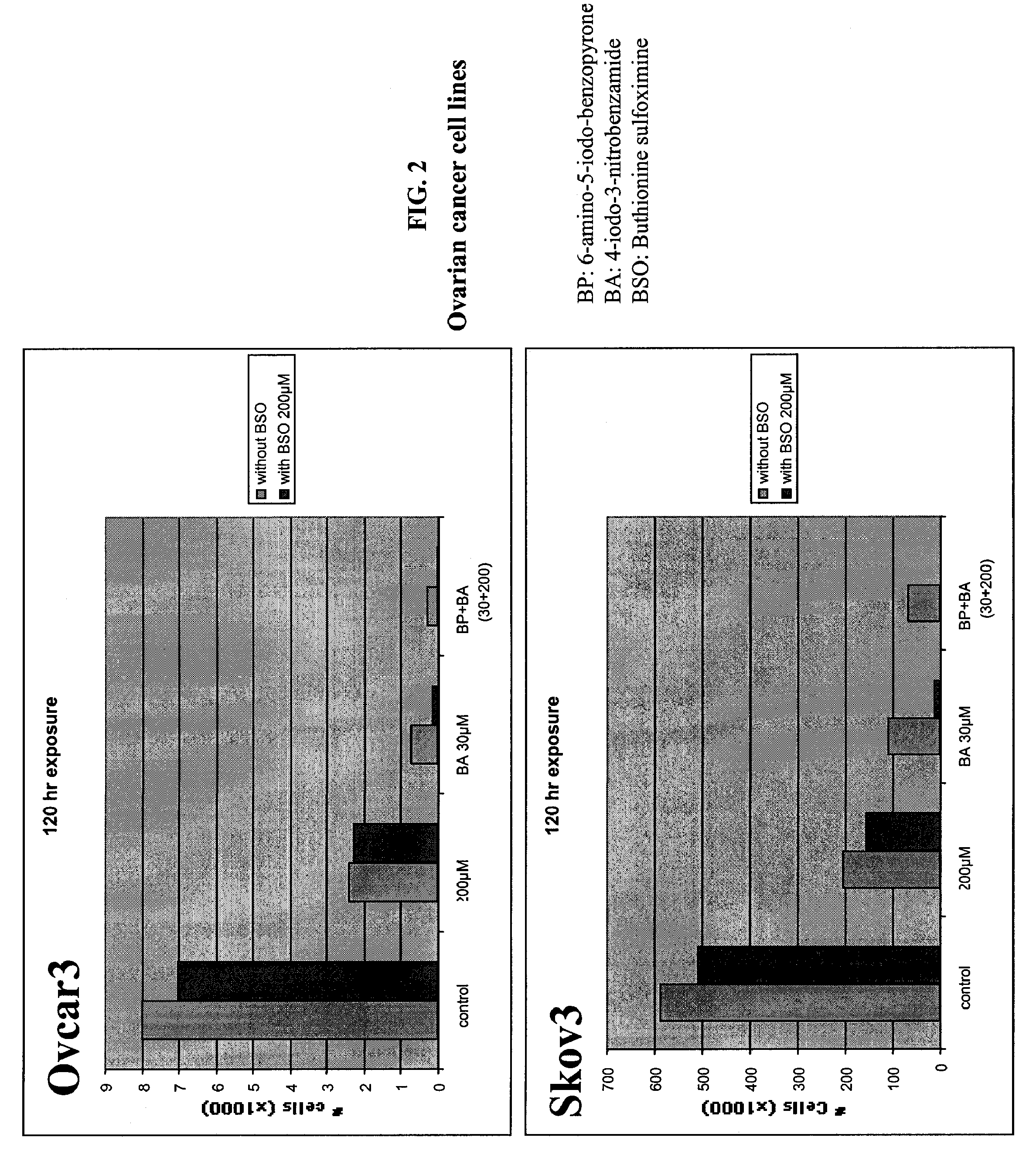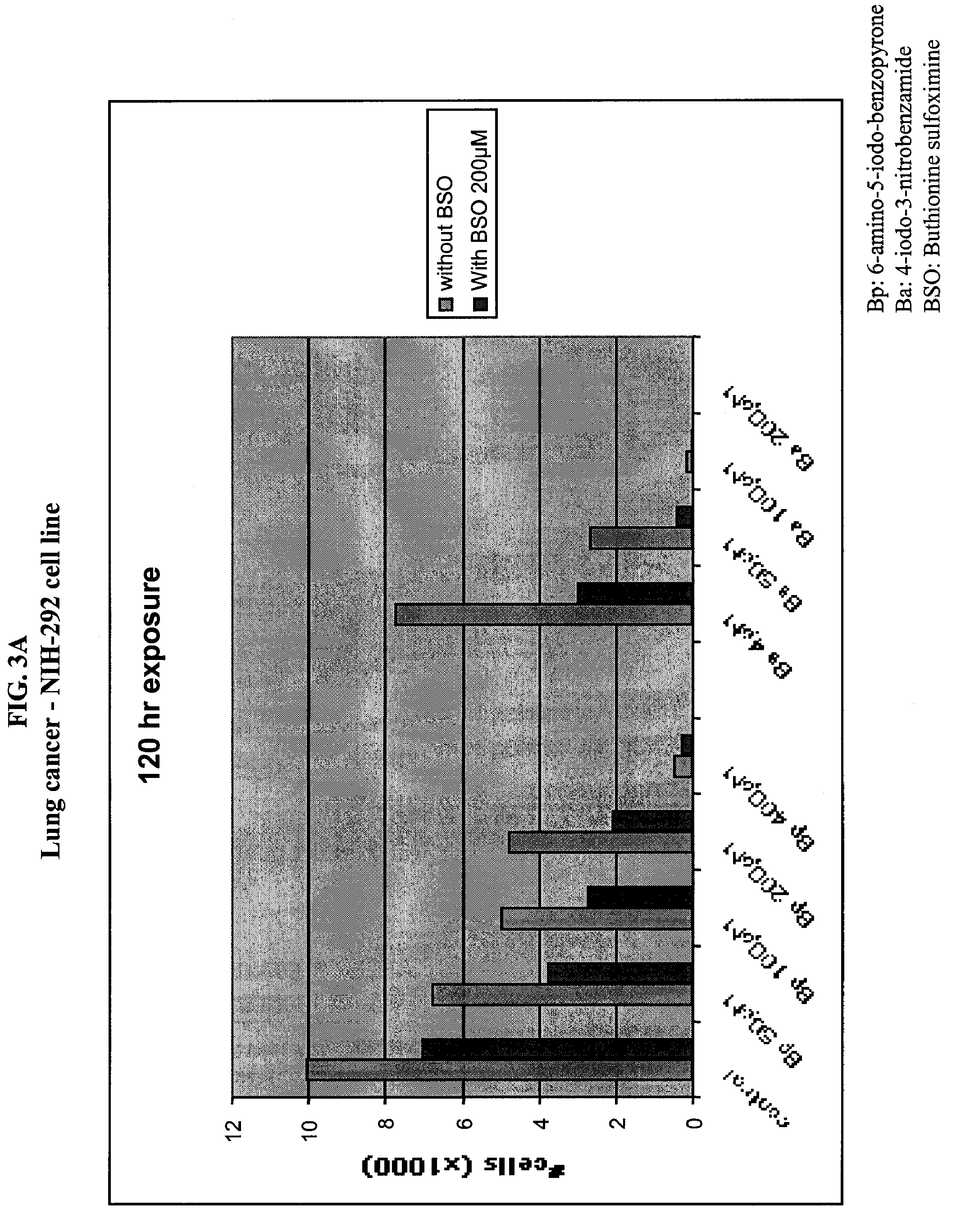Treatment of cancer
a cancer and cancer technology, applied in the field of cancer treatment, can solve the problems of malignant cancerous growth, serious challenges for modern medicine, and cancer is a serious threat to the modem society
- Summary
- Abstract
- Description
- Claims
- Application Information
AI Technical Summary
Benefits of technology
Problems solved by technology
Method used
Image
Examples
example 1
In Vitro Studies—Cytotoxicity Assays
[0186]Different types of cancer cell lines of different origin or primary cells were seeded (5×104) on 48 wells plate, or (2×104) on 96 wells plate. The cells were cultured in the appropriate medium. Cultures were maintained in a 37° C. incubator in a humidified atmosphere of 95% O2 / 5% CO2. After the cells were seeded (24 hours), medium was removed and replaced with culture medium in the presence of various concentrations of INO2BA or INH2BP, in the presence or not of 200 μM BSO. After 6 days of incubation at 37° C., cell viability was measured using the Cell Titer-Blue, Cell Viability Assay (Promega) (See O'Brien, J. et al. (2000) Investigation of the Alamar Blue (resazurin) fluorescent dye for the assessment of mammalian cell cytotoxicity. Eur. J. Biochem.267, 5421-26 and Gonzalez, R. J. and Tarloff, J. B. (2001) Evaluation of hepatic subcellular fractions for Alamar Blue and MTT reductase). This assay incorporates a fluorometric / colorometric gr...
example 2
Cell Proliferation Measured with BrdU-ELISA
[0189]The cells were incubated in the presence of various concentrations of the test substance (drugs) in a black 96-well MP (tissue culture grade; flat, clear bottom) at a final volume of 100 μl / well in a humidified atmosphere at 37° C. 10 μl / well BrdU labeling solution was added if the cells were cultured in 100 μl / well (final concentration: 10 μM BrdU) and the cells were reincubated for additional 2 to 24 hours at 37° C. (if the cells were cultured in 200 μl / well, 20 μl BrdU labeling solution was added). The MP was centrifuged at 300×g for 10 min and the labeling medium was removed with suction using a canulla. The cells were dried using a hair-dryer for about 15 min or, alternatively, at 60° C. for 1 h. 200 μl / well FixDenat was added to the cells and incubated for 30 min at 15-25° C. FixDenat solution was removed thoroughly by flicking off and tapping. 100 μl / well Anti-BrdU-POD working solution was added. This was incubated for approx. ...
example 3
[0191]
Study DesignImplantCells## TumorsGroupconditionsimplantedMiceneededTreatment (BID)1sc2 × 1072010none2sc2 × 1072010Vehicle (10%DMSO in saline)3sc2 × 1072010BP + BSO(175 mg / kg +220 mg / kg) P.O.4sc2 × 1072010BA (5 g / kg) I.P.5sc2 × 1072010Combo* (30 mg / kg)I.P. and P.O.*combination of BP + BSO and BA
[0192]100 female NU / NU-nuBR mice (Charles River, 5-6 wks) were implanted with 0.72 mg 17β-estradiol (human) pellets, ear tagged using clips and weighed 24-48 hours prior to tumor cell implantation. Tumor cells, BT474, (2×107 cells / mouse) were injected into the subscapular mammary fat pad (0.2 ml volume). Caliper measurements began on day 21 and three times weekly thereafter (Mon. Wed, Fri). Animals were segregated according to the presence and absence of tumor and then by tumor volume. Animals were weighed twice weekly beginning the 3rd week post implantation (Mon and Fri.). Drug treatment was started when tumor sizes were 150-250 mm3 (L*W*H). Drug and vehicle administration was BID by g...
PUM
| Property | Measurement | Unit |
|---|---|---|
| volume | aaaaa | aaaaa |
| volume | aaaaa | aaaaa |
| volume | aaaaa | aaaaa |
Abstract
Description
Claims
Application Information
 Login to View More
Login to View More - R&D
- Intellectual Property
- Life Sciences
- Materials
- Tech Scout
- Unparalleled Data Quality
- Higher Quality Content
- 60% Fewer Hallucinations
Browse by: Latest US Patents, China's latest patents, Technical Efficacy Thesaurus, Application Domain, Technology Topic, Popular Technical Reports.
© 2025 PatSnap. All rights reserved.Legal|Privacy policy|Modern Slavery Act Transparency Statement|Sitemap|About US| Contact US: help@patsnap.com



